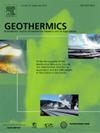The use of passive seismic noise to constrain seismic velocities in mountainous geothermal systems
IF 3.9
2区 工程技术
Q3 ENERGY & FUELS
引用次数: 0
Abstract
Geothermal hot-spots are often located in mountainous or volcanic areas, where strong heterogeneity and rough topography are expected. Medium-to-deep and deep geothermal projects require monitoring of the local seismicity, in order to reduce the seismic hazard associated with the operations. The location uncertainty of seismic events depends on many parameters, including the accurate knowledge of the subsoil in terms of seismic velocities. In this work passive seismic interferometry has been applied to one-year seismic ambient noise data recorded by a microseismic monitoring network close to Yverdon-les-Bains, Switzerland, where the development of some geothermal doublets is being considered. The proposed workflow is based on the retrieval of empirical Green’s functions from station pair correlations, on the estimation of phase velocities, and on their depth inversion. The adopted workflow considers and corrects for possible biases given by rough topography and non-homogeneous distribution of noise sources, an important source of errors in urbanized areas. The obtained quasi-3D seismic velocity model was used to relocate three seismic events in the vicinity of the geothermal project. The results show that seismic interferometry is a cost-effective method to infer a site-specific shear-wave velocity cube for the frequency range of interest for seismological applications. Passive data were also used to estimate the resonance behaviour of the study area, that reflects the great complexity of both subsurface structures and topography.
利用被动地震噪声约束山地地热系统中的地震速度
地热热点通常位于山区或火山地区,那里的非均质性强,地形粗糙。中深层和深层地热项目需要监测当地的地震活动,以减少与作业相关的地震危险。地震事件的位置不确定性取决于许多参数,包括根据地震速度对底土的准确了解。在这项工作中,被动地震干涉测量法已应用于瑞士Yverdon-les-Bains附近的微地震监测网记录的一年地震环境噪声数据,该监测网正在考虑开发一些地热双峰。所提出的工作流程是基于从站对相关性中检索经验格林函数、估计相速度和深度反演相速度。所采用的工作流程考虑并修正了由粗糙地形和非均匀噪声源(城市化地区的一个重要误差来源)可能造成的偏差。利用获得的准三维地震速度模型对地热工程附近的三个地震事件进行了重新定位。结果表明,地震干涉测量是一种经济有效的方法,可以推断地震学应用感兴趣的频率范围内特定地点的横波速度立方。被动数据还用于估计研究区域的共振行为,这反映了地下结构和地形的巨大复杂性。
本文章由计算机程序翻译,如有差异,请以英文原文为准。
求助全文
约1分钟内获得全文
求助全文
来源期刊

Geothermics
工程技术-地球科学综合
CiteScore
7.70
自引率
15.40%
发文量
237
审稿时长
4.5 months
期刊介绍:
Geothermics is an international journal devoted to the research and development of geothermal energy. The International Board of Editors of Geothermics, which comprises specialists in the various aspects of geothermal resources, exploration and development, guarantees the balanced, comprehensive view of scientific and technological developments in this promising energy field.
It promulgates the state of the art and science of geothermal energy, its exploration and exploitation through a regular exchange of information from all parts of the world. The journal publishes articles dealing with the theory, exploration techniques and all aspects of the utilization of geothermal resources. Geothermics serves as the scientific house, or exchange medium, through which the growing community of geothermal specialists can provide and receive information.
 求助内容:
求助内容: 应助结果提醒方式:
应助结果提醒方式:


